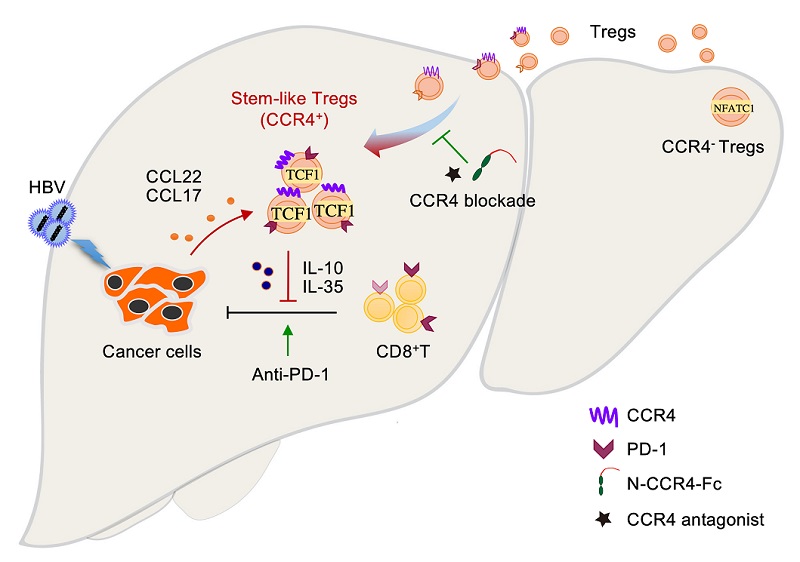Research Reveals Mechanism of Intratumoral Stem-like CCR4+ Tregs Orchestrate the Immunosuppressive Microenvironment in HCC Associated with Hepatitis B
Hepatocellular carcinoma (HCC) accounts for approximately 90% of primary liver cancers and ranks as the third most prevalent cancer worldwide. More than 80% of liver cancer is caused by hepatitis B virus (HBV) in China. The incidence of HCC increases with increasing viral load and duration of infection, suggesting an accumulating risk of tumorigenesis from this chronic inflammatory state. Sorafenib, the first-line systemic drug for advanced HCC, is preferentially resisted to HBV+HCC patients over HCC derived from other etiologies (Jackson et al. J Clin Oncol. 2017). HBV-associated HCC is often accompanied by severe vascular invasion and portal vein tumor thrombus leading to a poor prognosis. However, the mechanisms connecting inflammatory pathogenesis with carcinogenesis, and its ongoing effect in the induced tumor microenvironment (TME), remain largely unknown.
On September 12, 2021, Prof. YANG Pengyuan (Institute of Biophysics, Chinese Academy of Science) in a collaboration with Prof. WANG Fu-sheng (Fifth Medical Center of Chinese PLA General Hospital) published a research article entitled "Intratumoral stem-like CCR4+ regulatory T cells orchestrate the immunosuppressive microenvironment in HCC associated with hepatitis B" in Journal of Hepatology. This work revealed CCR4+ Tregs, the predominant type of Tregs in TME, exhibited specific cytokine-driven PD-1+TCF1+ stem-like properties to enhance tumor immune escape, thus CCR4 could be a potential precision target for enhancing the antitumor immunity by specifically blocking infiltration of Tregs into the TME and inhibiting intratumoral Treg cell pool maintenance.
Yang group has focused on the recruitment and functional mechanism of Tregs in TME over years. Previous studies showed that HBV can activate TGF-β signaling pathway to secrete chemokine CCL22 to escape from immune response (Cancer Cell, 2012); CCL22 signaling contributes to sorafenib resistance through TNFα/RIP1/NF-κB signaling pathway in HBV-associated HCC (Pharmacol Res, 2020); HBV-induced IL-8/CXCR1/TGF-β signaling promotes HCC venous metastasis and intrahepatic Treg accumulation (Cancer Res, 2021).
In this study, the researchers identified CCR4+ Tregs were the predominant type of Tregs recruited in the HBV-associated HCC, correlating with sorafenib resistance and HBV load titers. Compared with CCR4- Tregs, CCR4+ Tregs highly expressed IL-10 and IL-35, and enhanced functionality in suppressing the CD8+ T cells. Particularly, CCR4+ Tregs displayed PD-1+TCF1+ stem-like properties. ATAC-seq data revealed substantial chromatin remodeling between tumor-infiltrating Tregs (TIL-Tregs) and induced Tregs, suggesting that long-term chromatin reprogramming accounted for CCR4+ TIL-Tregs acquisition of enhanced immunosuppressive stem-like specificity. Treatment with CCR4 antagonist or N-CCR4-Fc blocked intratumoral Treg accumulation, overcame sorafenib resistance, and sensitized tumors to PD-1 checkpoint blockade therapy. Thus, intratumoral stem-like CCR4+ Tregs orchestrated resource cells of immunosuppression in TME. CCR4 could be a potential precision target for enhancing the antitumor immunity by specifically blocking infiltration of Tregs into the TME and inhibiting TIL-Treg pool maintenance.
This project was supported by the National Nature Science Foundation of China, Chinese Academy of Sciences and the Chongqing International Institute for Immunology.

Figure1. Working model
Article link: https://doi.org/10.1016/j.jhep.2021.08.029
References:
1. Gao Y#, You M#, Fu J#, Tian M, Zhong X, Du C, Hong Z, Zhu Z, Liu J, Markowitz GJ, Wang FS*, Yang P*. Intratumoral stem-like CCR4+ regulatory T cells orchestrate the immunosuppressive microenvironment in HCC associated with hepatitis B. Journal of Hepatology. 2021; doi: 10.1016/j.jhep.2021.08.029
2. Yang P, Li QJ, Feng YX, Zhang Y, Markowitz GJ, Ning S, Deng Y, Zhao J, Jiang S, Yuan Y, Wang HY, Cheng SQ, Xie D*, Wang XF*. TGF-β-miR-34a-CCL22 signaling-induced Treg cell recruitment promotes venous metastases of HBV positive hepatocellular carcinoma. Cancer Cell. 2012; 22(3): 291-303.
3. Gao Y#, Fan X#, Li N#, Du C, Yang B, Qin W, Fu J, Markowitz GJ, Wang H, Ma J*, Cheng S*, Yang P*. CCL22 signaling contributes to sorafenib resistance in hepatitis B virus-associated hepatocellular carcinoma. Pharmacol Res. 2020 Jul; 157: 104800.
4. Zhang C#, Gao Y#, Du C#, Markowitz GJ#, Fu J#, Zhang Z, Liu C, Qin W, Wang H, Wang F*, Yang P*. Hepatitis B-induced IL-8 Promotes Hepatocellular Carcinoma Venous Metastasis and Intrahepatic Treg Accumulation. Cancer Res. 2021 May 1; 81(9): 2386-2398.
5. Yang P#, Markowitz GJ#, Wang XF*. The hepatitis B virus-associated tumor microenvironment in hepatocellular carcinoma (Review). Natl Sci Rev. 2014; 1(3): 396-412.
6. Jia L, Gao Y, He Y, Hooper JD*, Yang P*. HBV induced hepatocellular carcinoma and related potential immunotherapy (Review). Pharmacol Res. 2020 Sep; 159: 104992.
Contact: YANG Pengyuan
Institute of Biophysics, Chinese Academy of Sciences
Beijing 100101, China
Email: pyyang@ibp.ac.cn
(Reported by Dr. YANG Pengyuan's group)

